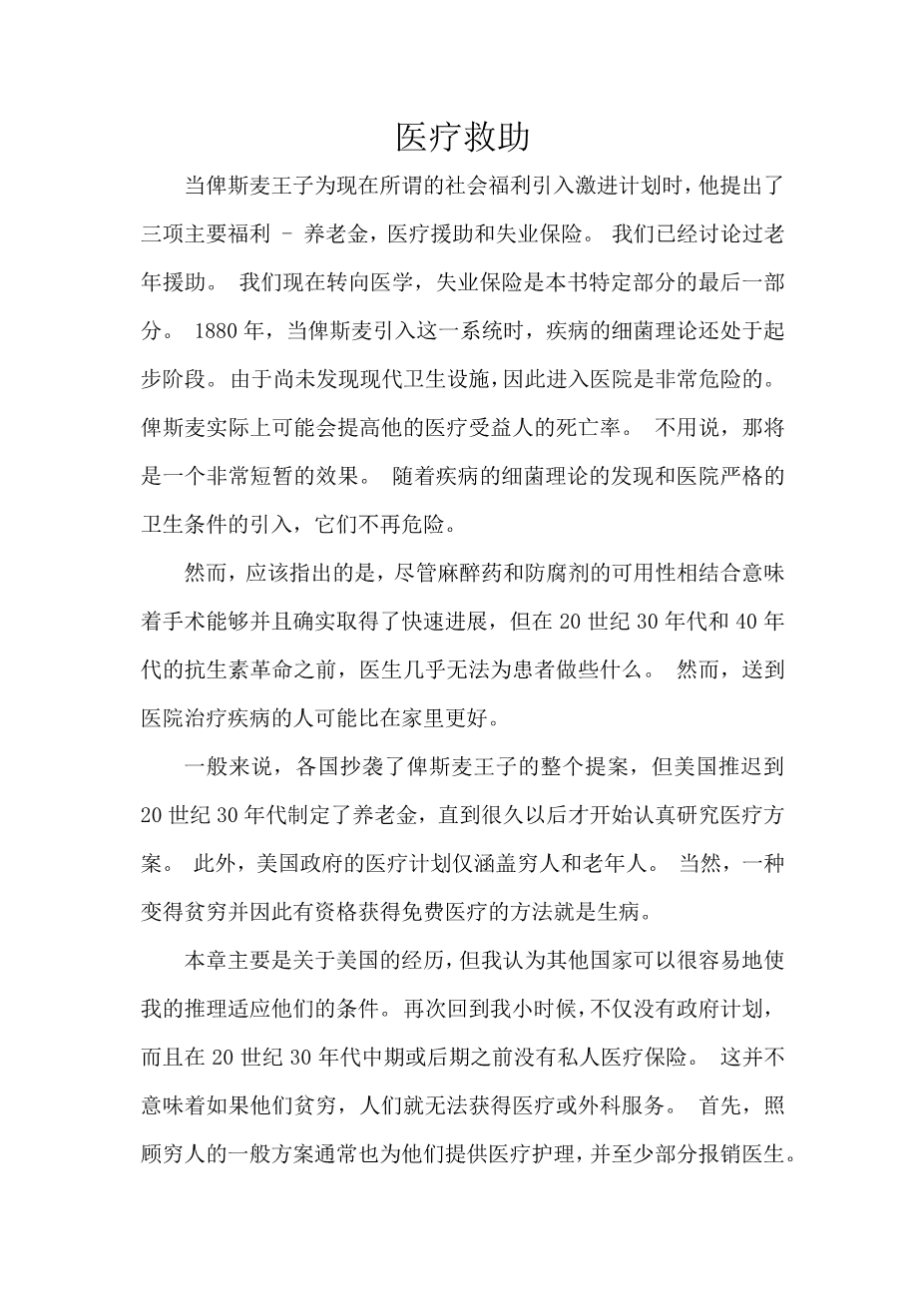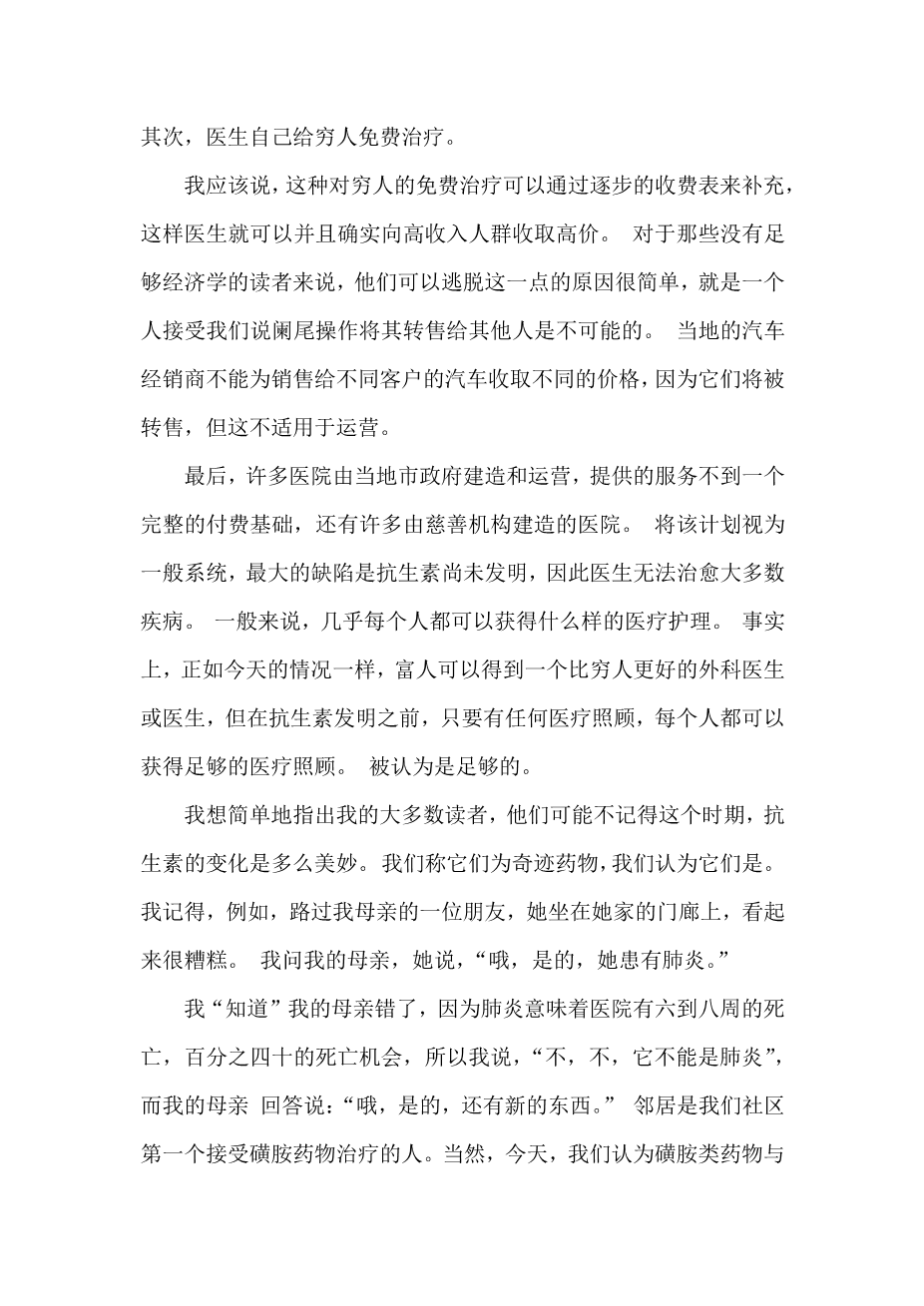8 MEDICAL ASSISTANCE
When Prince Bismarck introduced his radical program for what is now referred to as social welfare,147 he proposed three major benefits - old-age pensions, medical assistance, and unemployment insurance. We have already discussed old-age assistance. We now tum to medicine, and unemployment insurance is our last section in this particular part of the book. In 1880, when Bismarck introduced this system, the germ theory of disease was in its infancy. Entering a hospital was positively dangerous since modem sanitation had not yet been discovered. Bismarck actually may have increased the death rate among his medical beneficiaries. Needless to say, that would have been a very short-run effect. With the discovery ofthe germ theory of disease and the introduction of strict sanitary conditions in hospitals, they were no longer dangerous.
It should be pointed out, however, that although the combination of the availability of anesthetics and antiseptics meant that surgery could and did make rapid progress, there was really little that medical doctors could do for their patients until the antibiotic revolution of the 1930s and 1940s. Still, people sent to the hospital for treatment of diseases probably were better off than they would have been at home.
In general, various countries copied Prince Bismarck#39;s entire proposal, but the United States delayed enacting the old-age pensions until the 1930s and did not get seriously to work on medical programs until much later. Further, American government medical programs cover only poor and elderly people. Of course, one way of becoming poor and thus eligible for free medical attention is to become ill.
This chapter is primarily about the American experience, but I think that other countries can fairly readily adapt my reasoning to their conditions. Once again going back to when I was a boy, and there was not only no government program, but there was no private medical insurance until the mid- or late 1930s. This does not mean that people could not get medical or indeed surgical service ifthey were poor. In the first place, the general programs for taking careof the poor normally also provided medical attention to them and at least partially reimbursed doctors. Second, doctors themselves gave free treatment to the poor.
I should say that this free treatment for the poor was complemented by a graduated fee schedule so that doctors could and did charge high prices to people with high incomes. The reason that they could get away with this, for those of my readers who have not had enough economics, was simply that it is not possible for an individual who has received, let us say, an appendix operation to resell it to someone else. The local car dealers cannot charge different prices for cars sold to different customers because they will be resold, but that is not true of operations.
Finally, a great many hospitals were built and operated by local city governments and provided services on less than a full fee-paying basis, and a great many hospitals which were built by charitable institutions. Looking at the program as a general system, the great defect was that antibiotics had not yet been invented and hence doctors could not actually cure most diseases. What medical attention was available was, in general, available to almost everyone. It was true, as it is true today, that a wealthy person could get a better surgeon, or doctor, than could a poor person, but more or less everybody could get adequate medical attention insofar as any medical attention before the invention of antibiotics could be regarded as adequate.
I would like to digress briefly to point out to most of my readers, who probably don#39;t remember this period, what a wonderful change antibiotics made. We called them miracle drugs, and we thought they were. I recall, for example, passing by a friend of my mother#39;s who was sitting on the porch of her house and looking poorly. I asked my mother about it and she said, 'Oh yes, she has pneumonia.'
I 'knew' that my mother had to be wrong because pneumonia meant six to eight weeks in a hospital and a forty percent chance of death, and so I said, 'No, no, it can#39;t be pneumonia,' and my mother replied, 'Oh, yes, there is something new.' The neighbor was the first person in our neighborhood who had received a sulfa drug. Today, of course, we think of the sulfa drugs as rather primitive compared to the other things we have, but in those days they seemed an almost impossible cure. LG. Farben, in whose laboratories the inventor worked, of course, made a vast amount of money out of it, but I don#39;t think anybody regards this as an undue payment for these really immense achievements.
Returning to our main theme, this was the period of the great depression, and both doctors and hospitals found it rather difficult to get people to pay their bills. The hospitals, many of which were municipal and others charitable, organized themselves and founded a general insurance company that paid hospital expenses. You could buy the insurance, and the insurance company would take care of the hospital expenses. Needless to say, this, for the people who had the insurance, tended to eliminate the different prices for different wealth groups, although it was true, of course, that upper-income people could spend extra money and get private rooms, and so on. Toward the end of the 1930s, doctors organized another insurance company, which paid medical bills
It is obvious that medical problems are ideal for insurance, whether the insurance is private or public, because you cannot predict in advance when you will get seriously ill, and hence, it is not really a suitable place for simply bull; 148 savmgs.
At this time, of course, most European countries already had government help programs for the poor, and in many cases these covered the entire population, as almost all ofthem do now. In the United States,
全文共31127字,剩余内容已隐藏,支付完成后下载完整资料


英语译文共 14 页,剩余内容已隐藏,支付完成后下载完整资料
资料编号:[453435],资料为PDF文档或Word文档,PDF文档可免费转换为Word


